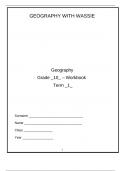GEOGRAPHY WITH WASSIE
Geography
Grade _10_ – Workbook
Term _1_
Surname ______________________________
Name ________________________________
Class ________________
Year _________________
1
,Index (add only page numbers at the end of the of term)
Topic 1 – Map skills (focus: topographic maps): Grade 8 and 9 Revision
Unit 1 – Constructed and Natural Features on topographic maps pg.
Unit 2 – The concept of contour Lines pg.
Unit 3 – Contour Patterns: Valley, Spurs, Ridges and Mountains pg.
Unit 4 – Scales and measuring distance pg.
Unit 5 – Coordinates to locate features pg.
Topic 2 – Map skills (focus: orthophoto maps): Grade 8 and 9 Revision
Unit 6 – Vertical aerial photographs pg.
Unit 7 – Contour Lines and height on orthophotos pg.
Topic 3 – Composition and structure of the atmosphere pg.
Unit 8 – Composition and structure of the atmosphere
Unit 9 – The Ozone layer
Topic 4 – Heating of the atmosphere pg.
Topic 5 – Moisture in the atmosphere pg.
Topic 6 – Reading and interpreting synoptic weather maps pg.
Assessments
Task Description Maximum marks Date
Test Control Test 2 60 TBA
2
,MAP SKILLS (FOCUS: TOPOGRAPHIC MAPS)
UNIT 1: CONSTRUCTED AND NATURAL FEATURES
Objectives (the second box is for scholars to tick off if they completed the objectives)
SWBAT: Read conventional map symbols to identify constructed and natural features
on topographic maps.
NEW WORDS
Conventional signs and Signs and symbols on a topographic map that represents the
natural and constructed features on the map.
symbols
Topographic map Topographic maps are detailed, accurate graphic
representations of features that appear on the Earth's surface. It
has a scale of 1: 50 000.
1.1 CONVENTIONAL SIGNS AND SYMBOLS
This is a standard sign used on a map to indicate a particular feature. These must be learnt
as they form the LANGUAGE of map work
A conventional sign is a standard sign used on a map to indicate a particular feature. The
conventional sign may be a letter of the alphabet or it may be a symbol. Many symbols look
like the features that they depict. If you know your signs you will be able to interpret every
map. Learn the colours, they give the clues as to what are natural features and which are
constructed (man-made).
There are SIX colour groups on topographic maps:
Brown: land or earth features - contours, eroded
areas, prominent rock outcrops, sand areas
and dunes, secondary or gravel roads
Blue: water features - aqueducts, canals, furrows
and siphons, coastlines, dams, lakes,
marshes, swamps and vleis, plains, rivers,
water-towers; national freeways are also
shown in blue
3
, Green: vegetation features - cultivated fields, golf
courses, nature and game reserve
boundaries, state forest boundaries, orchards
and vineyards, recreation grounds, woodland
Black: construction features - roads, tracks,
railways, buildings, bridges, cemeteries,
communication towers, dam walls,
excavations and mine dumps, telephone
lines, power lines, wind pumps, wrecks, ruins,
trigonometrical beacons, boundaries
Grey: construction features - built-up areas,
cadastral information
Red: construction features - national, arterial and
main roads, lighthouses and marine lights;
pink also shows international boundaries
Brown, blue and green generally represent natural features.
Black, grey and red generally represent the constructed (man-made) features.
What do the conventional signs look like?
The reference below is found on all topographic maps.
4




